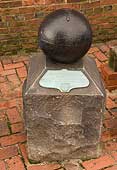
|
|
Related Documents
Download Options
| Image Name | Width x Height | Size |
|---|---|---|
| SIA2060.jpg | 480 x 761 | 97K |
| SIA2060.jpg | 900 x 1427 | 269K |
| SIA2060.jpg | 2336 x 3704 | 1M |
Caption
Like the bomb shell, the carcass was a hollow cast iron spherical shell weighting 190 pounds. It differed from the exploding bomb in that it was intended to set buildings on fire. It also proved useful at night, as the projectile, while burning, assisted in aiming other shells.
Instead of one vent hole for a single fuse, the carcass had three openings, each three inches in diameter. It was filled with an incendiary composition that upon firing burned for eleven minutes.
During the centennial observance in 1914, one of the Volcano's four carcasses shown in this picture was mounted on a granite pedestal which may be seen today alongside the 1814 powder magazine. This serves as a reminder of what may have happened if the events of September 1814 had turned in favor of the British.